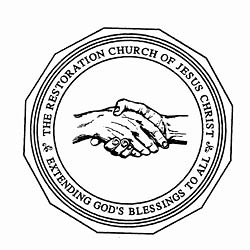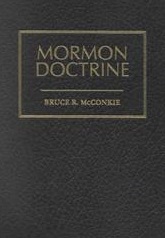The law of chastity is a moral code defined by the Church of Jesus Christ of Latter-day Saints. According to the church, chastity means that "sexual relations are proper only between a man and a woman who are legally and lawfully wedded as husband and wife." Therefore, abstinence from sexual relations outside of marriage, and complete fidelity to one's spouse during marriage, are required. As part of the law of chastity, the church teaches its members to abstain from adultery and fornication.

Affirmation: LGBTQ Mormons, Families, & Friends is an international organization for individuals who identify as gay, lesbian, transgender, bisexual, queer, intersex, or same-sex attracted, and their family members, friends, and church leaders who are members or former members of the Church of Jesus Christ of Latter-day Saints.

May Anderson was the second general president of the children's Primary organization of the Church of Jesus Christ of Latter-day Saints between 1925 and 1939. Anderson also served as the first counselor to general Primary president Louie B. Felt from 1905 to 1925.

The Restoration Church of Jesus Christ (RCJC), based in Salt Lake City, Utah, was a church in the Latter Day Saint movement that catered primarily to the spiritual needs of LGBT Latter Day Saints. It was founded in 1985 and was dissolved 25 years later in 2010.

All homosexual sexual activity is condemned as sinful by the Church of Jesus Christ of Latter-day Saints in its law of chastity, and the church teaches that God does not approve of same-sex marriage. Adherents who participate in same-sex sexual behavior may face church discipline. Members of the church who experience homosexual attractions, including those who self-identify as gay, lesbian, or bisexual remain in good standing in the church if they abstain from same-sex marriage and any homosexual sexual activity or sexual relationships outside an opposite-sex marriage. However, all people, including those in same-sex relationships and marriages, are permitted to attend the weekly Sunday meetings.
The Church Educational System (CES) Honor Code is a set of standards by which students and faculty attending a school owned and operated by the Church of Jesus Christ of Latter-day Saints are required to live. The most widely known university that is part of the Church Educational System (CES) that has adopted the honor code is Brigham Young University (BYU), located in Provo, Utah. The standards are largely derived from codes of conduct of the LDS Church, and were not put into written form until the 1940s. Since then, they have undergone several changes. The CES Honor Code also applies for students attending BYU's sister schools Brigham Young University–Idaho, Brigham Young University–Hawaii, and LDS Business College.

"God Loveth His Children" is a pamphlet produced by the Church of Jesus Christ of Latter-day Saints for members with same-sex attraction. It was approved in April 2007 and was announced in July 2007 through a letter to LDS Church bishops and stake presidents, and is available in 27 languages. It represents an official statement from the church, and follows an unofficial interview with apostle Dallin H. Oaks and general authority Lance B. Wickman in April of that year. The pamphlet is not new revelation or doctrinal change, but a continuation of the direction the church has been going in the past several years. However, church leaders say chances are slim it would deviate from its sanctions against active gay relationships.
Although the historical record is often scarce, evidence points to LGBT individuals having existed in the Mormon community since its beginnings, and estimates of the number of LGBT former and current Mormons range from 4 to 10% of the total membership of the LDS Church. However, it wasn't until the late 1950s that top LDS leaders began regularly discussing LGBT people in public addresses. Since the 1970s a greater number of LGBT individuals with Mormon connections have received media coverage.
This is a timeline of LGBT Mormon history in the first half of the 20th century, part of a series of timelines consisting of events, publications, and speeches about LGBTQ+ individuals, topics around sexual orientation and gender minorities, and the community of members of the Church of Jesus Christ of Latter-day Saints. Although the historical record is often scarce, evidence points to queer individuals having existed in the Mormon community since its beginnings. However, top LDS leaders only started regularly addressing queer topics in public in the late 1950s. Since 1970, the LDS Church has had at least one official publication or speech from a high-ranking leader referencing LGBT topics every year, and a greater number of LGBT Mormon and former Mormon individuals have received media coverage.

Because of its ban against same-sex sexual activity and same-sex marriage the Church of Jesus Christ of Latter-day Saints has a long history of teaching that its adherents who are attracted to the same sex can and should attempt to alter their feelings through righteous striving and sexual orientation change efforts. Reparative therapy is the pseudoscientific practice of attempting to change an individual's sexual orientation from homosexual or bisexual to heterosexual, or their gender identity from transgender to cisgender using psychological, physical, or spiritual interventions. There is no reliable evidence that such practices can alter sexual orientation or gender identity, and many medical institutions warn that conversion therapy is ineffective and potentially harmful.

The Church of Jesus Christ of Latter-day Saints has been involved with many pieces of legislation relating to LGBT people and their rights. These include playing an important role in defeating same-sex marriage legalization in Hawaii, Alaska, Nebraska, Nevada, California, and Utah. The topic of same-sex marriage has been one of the church's foremost public concerns since 1993. Leaders have stated that it will become involved in political matters if it perceives that there is a moral issue at stake and wields considerable influence on a national level. Over a dozen members of the US congress had membership in the church in the early 2000s. About 80% of Utah state lawmakers identied as Mormon at that time as well. The church's political involvement around LGBT rights has long been a source of controversy both within and outside the church. It's also been a significant cause of disagreement and disaffection by members.
This is a timeline of LGBT Mormon history in the 1950s, part of a series of timelines consisting of events, publications, and speeches about LGBTQ+ individuals, topics around sexual orientation and gender minorities, and the community of members of the Church of Jesus Christ of Latter-day Saints. Although the historical record is often scarce, evidence points to queer individuals having existed in the Mormon community since its beginnings. However, top LDS leaders only started regularly addressing queer topics in public in the late 1950s. Since 1970, the LDS Church has had at least one official publication or speech from a high-ranking leader referencing LGBT topics every year, and a greater number of LGBT Mormon and former Mormon individuals have received media coverage.
This is a timeline of LGBT Mormon history in the 1960s, part of a series of timelines consisting of events, publications, and speeches about LGBTQ+ individuals, topics around sexual orientation and gender minorities, and the community of members of the Church of Jesus Christ of Latter-day Saints. Although the historical record is often scarce, evidence points to queer individuals having existed in the Mormon community since its beginnings. However, top LDS leaders only started regularly addressing queer topics in public in the late 1950s. Since 1970, the LDS Church has had at least one official publication or speech from a high-ranking leader referencing LGBT topics every year, and a greater number of LGBT Mormon and former Mormon individuals have received media coverage.
This is a timeline of LGBT Mormon history in the 1970s, part of a series of timelines consisting of events, publications, and speeches about LGBTQ+ individuals, topics around sexual orientation and gender minorities, and the community of members of the Church of Jesus Christ of Latter-day Saints. Although the historical record is often scarce, evidence points to queer individuals having existed in the Mormon community since its beginnings. However, top LDS leaders only started regularly addressing queer topics in public in the late 1950s. Since 1970, the LDS Church has had at least one official publication or speech from a high-ranking leader referencing LGBT topics every year, and a greater number of LGBT Mormon and former Mormon individuals have received media coverage.
This is a timeline of LGBT Mormon history in the 1980s, part of a series of timelines consisting of events, publications, and speeches about LGBTQ+ individuals, topics around sexual orientation and gender minorities, and the community of members of the Church of Jesus Christ of Latter-day Saints. Although the historical record is often scarce, evidence points to queer individuals having existed in the Mormon community since its beginnings. However, top LDS leaders only started regularly addressing queer topics in public in the late 1950s. Since 1970, the LDS Church has had at least one official publication or speech from a high-ranking leader referencing LGBT topics every year, and a greater number of LGBT Mormon and former Mormon individuals have received media coverage.
This is a timeline of LGBT Mormon history in the 1990s, part of a series of timelines consisting of events, publications, and speeches about LGBTQ+ individuals, topics around sexual orientation and gender minorities, and the community of members of the Church of Jesus Christ of Latter-day Saints. Although the historical record is often scarce, evidence points to queer individuals having existed in the Mormon community since its beginnings. However, top LDS leaders only started regularly addressing queer topics in public in the late 1950s. Since 1970, the LDS Church has had at least one official publication or speech from a high-ranking leader referencing LGBT topics every year, and a greater number of LGBT Mormon and former Mormon individuals have received media coverage.
This is a timeline of LGBT Mormon history in the first decade of the 2000s, part of a series of timelines consisting of events, publications, and speeches about LGBTQ+ individuals, topics around sexual orientation and gender minorities, and the community of members of the Church of Jesus Christ of Latter-day Saints.
This is a timeline of LGBT Mormon history in the 2010s, part of a series of timelines consisting of events, publications, and speeches about LGBTQ+ individuals, topics around sexual orientation and gender minorities, and the community of members of the Church of Jesus Christ of Latter-day Saints.

Homosexuality has been publicly discussed by top leaders in the Church of Jesus Christ of Latter-day Saints —Mormonism's largest denomination—since the late 1800s. The frequency of teachings on same-sex sexual activity increased starting in the late 1950s. Most discussion focuses on male homosexuality and rarely mentions lesbianism or bisexuality. Below is a timeline of notable speeches, publications, and policies in the LDS church on the topic of homosexuality.








